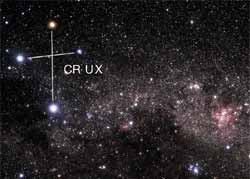
The Carina Milky Way arches across the sky during the short nights of the Southern Hemisphere summer. North is up. Click on the image to see the entire region from Crux to the False Cross.
Courtesy Akira Fujii.
Like many amateurs who live in the Northern Hemisphere, I spend a lot of nights with my telescope aimed low toward the south, whether observing at home in British Columbia, in the southern United States, in Mexico, or in the Caribbean. So spending the dark of the Moon in March 2001 at two dark Australian sites as a guest of the Astronomical Society of New South Wales (ASNSW) was the fulfillment of a lifelong dream. Here are notes on a few of my trip's highlights including the Eta Carinae Nebula, the Dark Doodad, and the Vela supernova remnant.
Glories of Carina
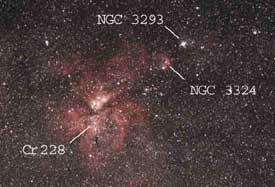
The dust-crossed Eta Carinae Nebula, at the center of this photograph, is flanked by several star clusters and nebulae. North is up. Click on the image to see a view that includes IC 2602 and NGC 3532.
Courtesy Luke Dodd.
The heart of the southern Milky Way is the magnificent Eta Carinae Nebula (NGC 3372), which North American pilgrims enthusiastically observe every February from Florida's Winter Star Party. This showpiece is framed by three naked-eye open star clusters: NGC 3114, the large and very bright IC 2602 (also known as the Southern Pleiades), and the football-shaped swarm of what is arguably the sky's finest cluster, NGC 3532. I zoomed in over the huge emission nebula's outer filaments, over its many silhouetted dust clouds, over the large scattered cluster Collinder 228 in its southern section, over its brilliant central masses bifurcated by a chevron-shaped dark lane, over the star sprays of the embedded clusters Trumpler 14 and 15, and then concentrated on the young stars of arrowhead-shaped Trumpler 16, a rich open cluster at the southern end of the dark Keyhole Nebula.
Trumpler 16 holds the very bright, very tiny (15") Homunculus Nebula, a bipolar shell of dust and gas that surrounds the supergiant star Eta Carinae (R.A. 10h 45m 03.6s, Dec. -59° 41" 04', equinox 2000.0). The intensely colored Homunculus Nebula is as orange as Antares. I studied it with ASNSW member Andrew Murrell's 20-inch f/5 Dobsonian at 363x on a very steady night at the site where the South Pacific Star Party was later held. Amazingly, I was able to see the major features that are visible on the Hubble Space Telescope image. The western lobe was narrower and had a tiny dusky inclusion; the eastern lobe was wider and had two tiny dark inclusions arranged along the Homunculus's major axis. Tiny spikes extended both northwest and southeast of the obscured star, with the northwestern spike being the sharper of the two. This detailed view of matter thrown off by the unstable star during its famous 19th-century outburst was perhaps the most exciting part of my trip.
The emission nebula NGC 3324 would be more famous were it not overshadowed by the nearby Eta Carinae Nebula. Seen through ASNSW member and South Pacific Star Party cofounder Tony Buckley's 14½-inch f/7 Dobsonian at 81x, NGC 3324 was a nebulous two-lobed patch. A bright yellow star adorns the southern lobe; the northern lobe of nebulosity is crescent-shaped. The view improved noticeably when a Lumicon ultra-high-contrast (UHC) filter was threaded onto the eyepiece. Intriguingly, the Millennium Star Atlas and NGC 2000.0 both suggest that a cluster is involved with this nebula, but none was apparent at the eyepiece.
The faint emission and reflection nebula NGC 3293 surrounds a splendid open cluster sharing the same NGC number. That cluster was an incredibly tight ball of stars in the 14½-inch at 81x. A line of three bright stars, one orange, highlights the center. A long, dark nebula coursed to the west of the open cluster, and a tiny one lay immediately to the east. Without a filter there was only a hint of the diffuse emission nebulosity seen in photographs. But with a UHC filter and a magnification of 136x the cluster was enmeshed in nebulosity, and the long dark lane became more obvious.
Darkness and Light in Musca
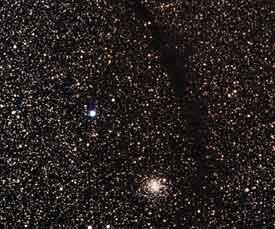
The loose globular cluster NGC 4372 dangles at the southern end of the Dark Doodad, an unusually well defined dark cloud just south of the Southern Cross. Stefan Binnewies, Bernd Schröter, Harald Tomsik, and Peter Riepe took this 3°-wide photograph from Namibia with an Astro-Physics 4-inch f/6 refractor. Click on the image to see the entire dark cloud.
Courtesy VdS-Fachsgruppe Astrophotographie
One of the finest dark nebulae, the wonderful, winding, 3°-long Dark Doodad is a Musca highlight. Interestingly, after observing it at 81x with the 14½-inch, I found that the Millennium Star Atlas and I had picked the same stars to mark the ends of this dust cloud. It is highly unusual for the boundaries of a large dark nebula to be so definite. Beside the bulbous southern end of the Dark Doodad is the globular cluster NGC 4372 (12h 25.8m -72° 39'). At 136x it was so loosely scattered that it resembled an open cluster, except for its underlying glow. I saw no real patterns to the globular's resolved stars except for an unusual number of pairs. A 7th-magnitude yellow gem highlights the cluster's northwestern margin.
Several Australian amateurs told me not to miss the very unusual Musca planetary nebula NGC 5189 (13h 33.5m -65° 58"), and it turned out to be an unexpected delight. Seen through the 14½-inch at 136x with an oxygen-III (O III) filter, it resembled a barred spiral galaxy, just as Ernst J. Hartung's guidebook, Astronomical Objects for Southern Telescopes, says. Within a large, mottled ellipse of nebulosity, elongated from east to west, there is a brighter northeast-to-southwest arc (the "bar"). An additional knot was spotted beyond the eastern end of the oval. Hartung, who observed with a 12-inch Newtonian, called this knot bluish. John Herschel, the planetary's discoverer, called NGC 5189 "a very strange object."
A Sprawling Supernova Remnant
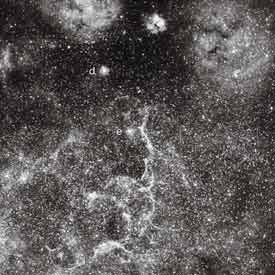
The tattered result of a massive stellar explosion, the Vela supernova remnant sprawls across more than 20 square degrees of the far-southern sky. Taken from Chile with a 180-mm f/2.5 lens and a hydrogen-alpha filter, the image reveals much of the remnant's extensive network of glowing gaseous filaments. The bright stars d and e Velorum are labeled. North is to the upper right. Click on the image to see more of the remnant.
Courtesy Michael Stecker.
When I was making the hit list for my Southern Hemisphere observing run I asked a group of experienced observers whether the Vela supernova remnant (Vela SNR) could be seen visually. Atlanta-based observer Alex Langoussis replied, "You could spend hours following all the visible filaments." That caught my attention!
The tattered remains of a supernova explosion that took place 20,000 to 30,000 years ago, the Vela SNR sprawls across more than 20 square degrees of sky and is centered roughly at R.A. 8h 36m, Dec. -45°. One night I attempted to see the Vela SNR from a dark site on the western edge of Wollemi National Park with Buckley's fine 14½-inch and an O III filter. I saw only three filaments near the 4th-magnitude star e Velorum. While those three filaments were not particularly difficult, I saw nothing definite in the southern part of the remnant. However, on that night the seeing was so poor that I couldn't split Acrux, even though its two very bright components were only 4.0" apart. What's more, I was exhausted, as the heat and the raucous kookaburras had kept me from getting a good day's sleep, and I was observing in a very uncomfortable position (hunched over on the third step of a ladder for two excruciating hours). These three factors apparently reduced my ability to discern elusive nebulosity. At home I wouldn't have tried to do serious observing when the seeing was that poor, but you can't afford to be choosy when on an observing run in another hemisphere.
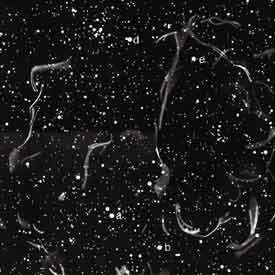
German observer Ronald Stoyan used the MegaStar software program to plot the star field around the Vela SNR. He then sketched the parts of the remnant that he was able to see (from Namibia) through a 20-inch f/5 Newtonian telescope with an oxygen-III filter. The labeled stars are a, b, d, and e Velorum. North is up. Click on the image for a larger view.
More can be seen of the Vela SNR under more favorable conditions. Langoussis had "legendary" seeing when he explored the remnant at the 1997 Winter Star Party with an O III filter and his 15-inch f/5 Dobsonian. Observing at 54x he'd "try to follow each individual strand, and try to work [his] way back and catch the next, in order to see everything." Sky & Telescope contributing editor Sue French had a comparable view with her 4.1-inch f/5.8 refractor. With the obligatory O III filter "large swaths of very complex nebulosity were visible" at 17x, she reports. "The brightest sections lie north and west of e Velorum. A large, detached 'T' of nebulosity lies east of the main, sprawling complex."
Observers in Australia, South Africa, and other lands south of the equator need no encouragement to seek out these remarkable nebulae. But if you live north of the Tropics, I heartily recommend that you pack a portable telescope and observe some of these objects if you head south for a winter vacation.
 0
0
Comments
You must be logged in to post a comment.